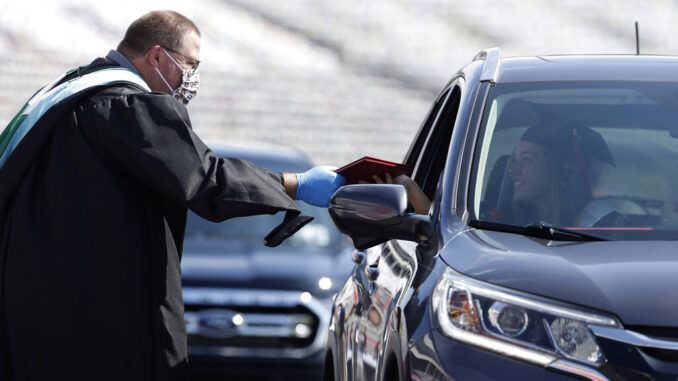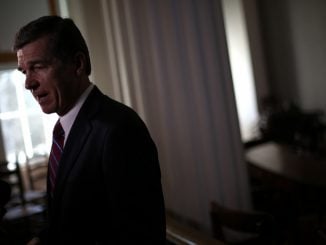
RALEIGH — Earlier this month, the anniversary of one of the most impactful and controversial decisions in North Carolina education history passed without so much as a mention from state officials.
On March 10, 2020, Gov. Roy Cooper issued executive order No. 116, declaring a state of emergency because of the emerging COVID-19 pandemic. Four days later, Cooper followed that with executive order No. 117, which prohibited mass gatherings and also closed public schools through the end of the month.
Just over six weeks later, Cooper announced all schools would remain closed through the rest of the school year.
N.C. Department of Health and Human Services (NCDHHS) Secretary Mandy Cohen, now director of the Centers for Disease Control and Prevention (CDC) for the Biden administration, unveiled the “Strong Schools Toolkit” in June 2020 to provide guidance during the pandemic.
The 26-page Toolkit contained requirements for school operations, including masking, infection screening, personal protective equipment, as well as ventilation and water safety. The state’s districts would defer to the Toolkit for school reopening and masking throughout the pandemic.
Cooper and Cohen relied heavily on CDC guidance, as did the Toolkit, yet that guidance would come into question a little under two years later when a Congressional committee found the CDC had allowed the American Federation of Teachers to rewrite key portions of school reopening guidance that had kept most schools closed. In some cases, the CDC had used AFT’s suggestions nearly verbatim.
In mid-July, Cooper held a press conference unveiling plans for schools to reopen while implementing moderate social distancing with 50% rotating attendance capacity and “blended learning.”
As the 2020-21 school year began, Republican lawmakers pressed Cooper to end all remote instruction and return children to the classroom. Senate Majority Leader Phil Berger (R-Eden), former Lt. Gov. Dan Forest and State Superintendent candidate Catherine Truitt held a press conference during which Berger called remote learning “a slow-motion train wreck.”
The day after the press conference, on Sept. 17, 2020, Cooper said districts could opt to open elementary schools for in-person instruction. A month after Cooper’s suggestion for elementary schools, the majority of the state’s 115 districts remained in remote instruction mode. On Feb. 2, 2021, Cooper encouraged districts to move to in-person instruction.
By the end of that month, lawmakers passed Senate Bill 37 with bipartisan support to reopen the state’s schools for in-person learning to all students, not just those in elementary grades.
A Cooper veto was followed by negotiations with legislators, and it led to a deal to reopen schools. The press conference announcing the deal — which featured Cooper, Truitt and legislative leaders — came exactly a year after Cooper declared his initial state of emergency, which ended up lasting 888 days.
The impact on students lasted much longer.
“When I assumed office in January 2021, North Carolina public schools were still closed because of the pandemic,” Truitt told North State Journal. “Ensuring the health and safety of students and school staff remained a top priority, but our team was working diligently to reopen schools because we knew it was best for student learning and mental health. We knew that in-person learning was really imperative, and with the proper supports in place, we were confident we could safely reopen schools for all.
“The first few months in office during the pandemic were challenging for a myriad of reasons, but I was determined to use that blip in time to rewrite the public school playbook.”
Nationwide, the closures had led more families to look for alternatives to public schools, with interest in homeschooling, charter schools and private schools growing significantly. At the same time, teachers threatened to quit, school boards found themselves the focus of protests and student achievement plummeted to a 30-year low across the country.
North Carolina students were later estimated to be 15 months behind. Students with special needs in the state were hardest hit as remote instruction failed to meet their needs. Two years after the closures, those students were showing a steep decline in academic performance and increased behavioral issues.
Truitt said, post-pandemic, she knew there was an “appetite for change.”
“There was a widespread desire to really rethink the way the K-12 system operated,” she said, “and this was the glass-half-full mentality we charged ahead with when crafting Operation Polaris and putting a four-year vision in place to better serve students, teachers and parents. Four years later, I’m really proud of what has been accomplished.”
Academic achievement has improved in North Carolina, especially in K-3 literacy — post-pandemic, students in the state have outperformed the nation. Truitt credited the success to the implementation of the phonics-based reading program called Language Essentials for Teachers of Reading and Spelling (LETRS).
“North Carolina has seen two years consecutive years of post-pandemic academic recovery across virtually all subjects and all grades,” said Truitt. “Our K-3 students have achieved double-digit gains greater than the rest of the nation on early literacy assessments, and the number of career and technical education credentials students earn before completing high school is the highest in state history.”
It’s still just the start of the recovery from the pandemic shutdown.
“There is always more that can and should be done,” said Truitt, who lost her bid for reelection in last month’s Republican primary, “and I look forward to the work to come in the remainder of 2024.”


